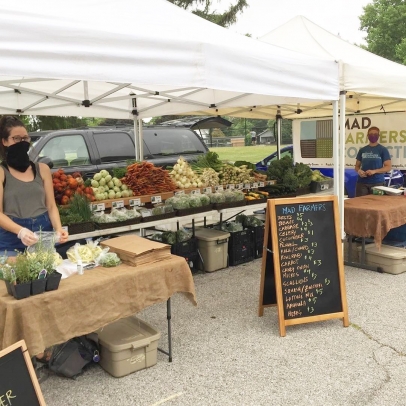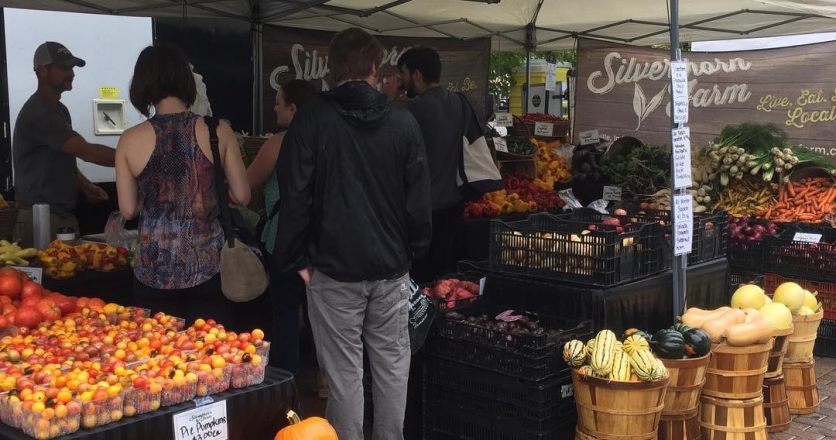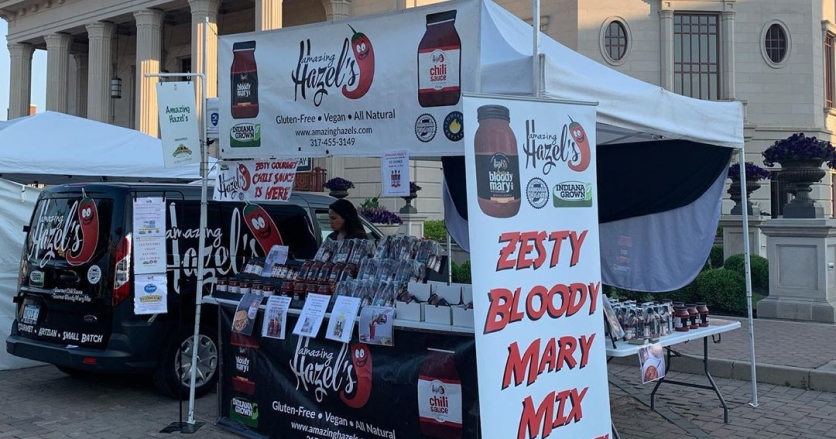The Now of Farmers Markets
Restaurants closed. Theaters darkened. Parks emptied. For every day social distancing is in effect, it becomes more and more apparent how important human connection is, and how much we took it for granted.
But once a week, there is a place at the center of communities across Indiana where the loneliness of COVID-19 is especially noticeable. At farmers markets all over the state, a bizarre emptiness has replaced the once bustling atmosphere of neighbors connecting with one another over locally-grown food.
As farmers markets navigate the ongoing health crisis, a few questions arise. How have markets changed? How are vendors, customers and community members impacted by the loss of their Saturday morning tradition? And what does the future hold?
Though a lot remains uncertain, here’s what we know now:
New rules
Each market is in charge of following the regulations agreed upon with their county health departments. In most cases, social distancing is enforced, no dogs are allowed, no eating or drinking is permissible on site and shopping time is limited. Many vendors have also set up pre-packaging, pre-ordering and no-contact pickup systems to avoid the spread of germs.
Lots of markets are going above and beyond what’s required by the health department by setting up extra sanitizer stations, placing tables in front of vendors and selling masks. The Zionsville Market even has an hour at the beginning of their market where only at-risk shoppers can enter.
Ashley Brooks, board president of Garfield Park Market, says it was initially a struggle to get approval to operate at all. Several market organizers teamed up to prove to the Health Department why locally-made food is an essential product.
“We just made our case for why we thought it was important for us to be able to open,” says Ashley. “It’s really one big collaboration to make sure we’re doing this safely.”
Vendors
In spite of the hard work each market is putting in to keep their markets running, vendors are suffering. Stricter regulations and less customers mean less revenue, and many farmers are fighting to keep their businesses afloat.
David VanWye, owner of Amazing Hazel’s, says his business is down by 95%. He’s not allowed to sell at some of his usual locations because his sauces do not qualify as an essential product, and he now relies almost entirely on selling his margarita mix on Amazon and in Kroger and Fresh Thyme.
“I do understand it’s for public health, I do understand it’s necessary,” says Dave, “but it does adversely affect the little guy like me, drastically.”
Silverthorn Farms co-owner Nate Parks says it’s hard to gage what the new normal is, but he’s starting by having his employees wear masks and sanitize more often. And like many other farmers, he’s trying to increase his business’s online presence.
What’s frustrating to him is the difference in restrictions between grocery stores and farmers markets. While there’s minimal rules on how close people can get in the produce section of the larger grocery stores, farmers have had to fight to prove why they’re equally essential, causing much uncertainty as to whether or not they’ll be able to get their product to their customers.
“We’re just not sure where we’re going to sell our food, that’s the scary part,” says Parks.
Community loss
The literal barriers put in place between farmers and their customers sadly create figurative ones as well. Many defining social characteristics of markets, such as live music, food trucks and conversing with other market-goers, are no longer safe to have.
Now that markets exist strictly to sell essential food products, they are no longer viable environments for human connection. Though it might not be the biggest concern now, this could negatively impact the mental health of individuals and the strength of communities.
Marcia Veldman, Bloomington Farmers Market coordinator, recalls the market immediately after 9/11. People showed up just to talk with others about the tragedy and make sense of what happened. This time, however, the thing that people most want to discuss at the market is what’s preventing them from even going.
“There’s something incredibly valuable for a community to have a point of connection on a regular basis,” says Veldman . “There’s relationships that have developed over decades.”
That connection doesn’t just go one way. The people on the other side of the stands miss the interaction just as much as their customers do.
“It’s just eerie now,” says Nate Parks. “It removes all those connections and relationships we’ve built, putting those barriers up.”
Looking forward
It’s unclear how farmers markets will be affected long term, but the COVID-19 restrictions will likely relax in the coming months. It is up to the Health Department and the management teams of each market to monitor the situation and update their policies accordingly.
Josie Taylor, pr manager at Indy City Market, isn’t sure that things will ever go completely back to normal. But she also doesn’t think that’s necessarily a bad thing. In their efforts to adapt, vendors have displayed exciting innovation in accessibility and online activity that could carry into future years.
“We are seeing these small businesses step up to the plate,” says Josie. “It’s going to spark creativity, and hopefully that creativity will extend to any future market season.”
As for the social aspects of farmers markets, Zionsville Market manager Kristin Nester is optimistic that all will be restored. In fact, she thinks people will have a newfound appreciation for the live music, picnicking and human interaction.
“I’d like to believe that farmers markets are going to be bigger and better than ever because we’ll have realized how special they are,” says Nester.
Increases in local support is evident within communities and people educating themselves on where the products are coming from and how it is produced.
How to help
Although the future of farmers markets is out of our hands, there are still a few things we can do to support vendors.
For starters, check out the time and location of your town’s farmers market. And if you can’t show up in-person, look for the online ordering and no-contact pick up options offered by each business. It might be easier than you think to get your hands on fresh, locally grown food, even during a national pandemic.
It’s also imperative to follow the social distancing rules put in place by each market. The sooner the country gets healthy, the sooner farmers markets go back to the vibrant community hubs they used to be.
And most importantly?
“Buy local,” says Dave VanWye. “Don’t go to the big box stores if you don’t have to.”
The demand for local affordable, fresh and healthy foods has grown during the
covid-19 pandemic… but is this current trend the whole iceberg or just the tip?
The 2020 World Population Review shows Kentucky, Indiana and Ohio have 8,936,574
households. Imagine for a moment what growing impact we could have this year. What if
every household in the three states was able to either start to spend or increase spending on
regionally grown products by just $10 per week for the next 16 weeks, taking us through the
heart of the harvest season? Apply this thinking to any or all food distribution channels —
farmers’ markets, CSAs, grocery stores, home delivery services, restaurants.The impact on our farmers and local food businesses would be tremendous:
8,936,574 households × $10 × 16 weeks = $1,429,851,840!
Let me repeat: “The impact on our farmers and local food businesses would be tremendous —
with an added multiplier effect — the economy, taste buds, health and more.
Think about it.” - Steve Makela, Publisher, Edible Kentucky & Southern Indiana








